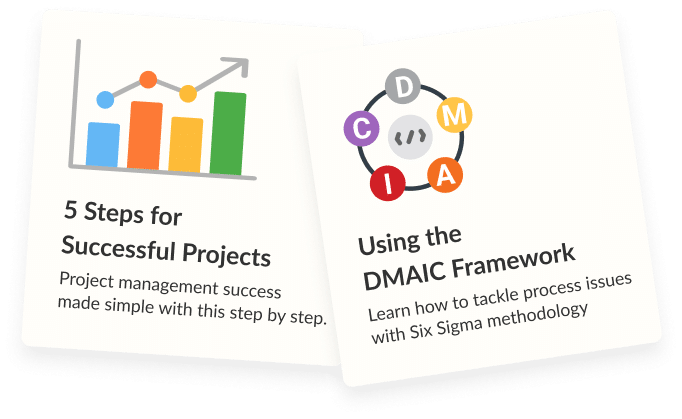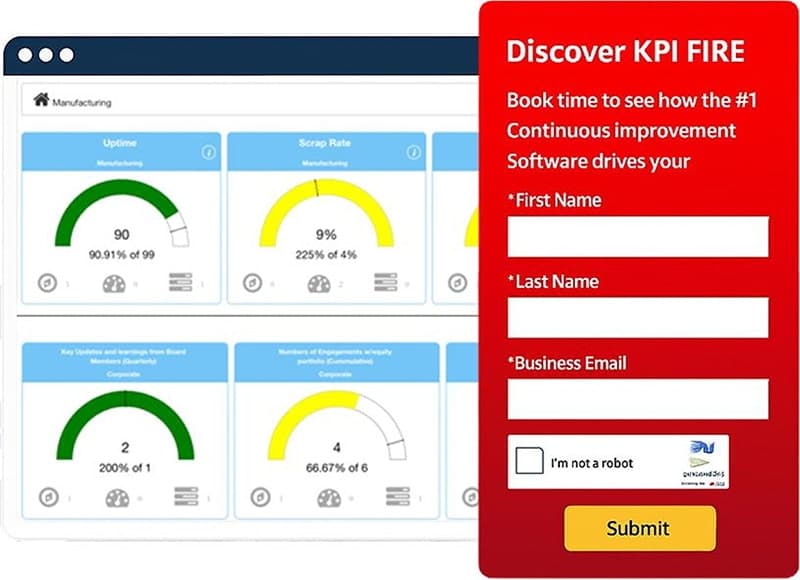Want to Improve Faster? Learn how to measure, track, and optimize your improvement efforts with these 9 proven metrics.
In today’s rapidly evolving business landscape, a continuous improvement management system is no longer a nice-to-have, but a must-have for organizations to thrive. This article will explore 9 key metrics that can help you track progress and drive meaningful change within your organization. Whether you’re a business owner, a manager, or a team leader, this guide will provide you with actionable insights and practical tips for implementing a successful continuous improvement strategy.
Main Takeaways from This Article
- Why Continuous Improvement metrics are essential
- What are the most important metrics to use?
- How to execute effective measurement of Continuous Improvement metrics.
- The benefits of using KPI Fire to track & manage metrics
What Are Continuous Improvement Metrics?
Continuous improvement metrics are measurable indicators used to track progress in improvement efforts across key areas such as efficiency, quality, and customer satisfaction. These metrics offer a structured way to evaluate the effectiveness of improvement initiatives, identify areas for further action, and demonstrate the overall impact of continuous improvement efforts on the organization’s performance.
The Importance of Continuous Improvement Metrics
Continuous improvement metrics provide crucial data to drive informed decisions, ensuring that improvement efforts are aligned with strategic objectives. By tracking these metrics, organizations can objectively measure the effectiveness of their initiatives, identify areas for further action, and demonstrate the return on investment for improvement programs. This data-driven approach enables organizations to enhance efficiency, optimize resource allocation, and improve customer loyalty, ultimately driving sustained organizational success and a competitive advantage in the market.

Build a Culture of Improvement – Get the Free CI Toolkit!
Learn to engage teams, drive operational excellence, and lead change with confidence.
- Align improvement efforts with strategy
- Daily huddleboard & templates
- Build leadership at every level
- Tools to increase accountability & engagement
Read more about the Continuous Improvement Program.

Request a Demo

Top 9 Metrics for Continuous Improvement Initiatives
Continuous improvement initiatives are critical for organizations to remain competitive and adapt to evolving market demands. Tracking key metrics provides insights into the effectiveness of these initiatives and helps identify areas for further optimization.
1. Customer Satisfaction
Customer satisfaction is a critical metric as it directly impacts customer loyalty, repeat business, and overall business success. Satisfied customers are more likely to become repeat customers, refer others, and remain loyal to the brand. Collecting customer feedback through surveys, complaint analysis, and social media monitoring provides valuable insights into customer perceptions. Visual management boards can effectively display customer satisfaction trends, allowing teams to easily identify areas for improvement and track progress over time.
2. Cost Reduction
Cost reduction is a strategic objective for continuous improvement programs, aiming to enhance profitability and competitiveness. Key metrics include ROI, production costs, unit costs, and overall cost savings. By tracking these metrics, organizations can identify areas with high cost drivers, prioritize improvement efforts, and allocate resources effectively. For instance, a manufacturing company might discover that optimizing raw material usage through lean practices significantly reduces production costs, leading to improved profitability and increased market share.
3. Overall Equipment Effectiveness (OEE)
Overall Equipment Effectiveness (OEE) is a critical metric for manufacturing companies as it measures the true effectiveness of production equipment. OEE is calculated by considering three key components: availability (time the equipment is actually producing), performance (speed at which the equipment is running), and quality (percentage of good parts produced).
Methods for measuring equipment efficiency include direct observation, data collection from equipment sensors, and production records analysis. KPI Fire’s performance dashboards provide real-time monitoring of OEE, enabling organizations to identify bottlenecks, track improvement efforts, and make data-driven decisions to optimize equipment utilization and overall productivity.
4. Employee Engagement
Engaged employees are crucial for successful improvement initiatives. They are more likely to contribute ideas, take ownership of their work, and actively participate in improvement projects. Tracking metrics like employee satisfaction surveys, participation rates in improvement projects, and training completion rates provides insights into employee engagement levels. Using visual representation tools, such as dashboards and progress charts, can effectively communicate engagement trends and motivate employees to contribute to continuous improvement efforts.
5. Product Quality
Product quality plays a crucial role in driving customer loyalty and reducing customer complaints. High-quality products meet customer expectations, leading to increased satisfaction and repeat business. Key metrics include defect rates, rework costs, and first-pass yield. By analyzing these metrics and conducting root cause analysis, organizations can identify and address the underlying issues that lead to quality problems. Data-driven decision-making based on these insights enables proactive quality improvement efforts, ultimately enhancing customer satisfaction and improving the bottom line.
6. Delivery Performance
Delivery performance metrics, such as on-time delivery rates and lead times, significantly impact customer satisfaction and competitive advantage. Meeting delivery promises builds trust and loyalty, while exceeding expectations can provide a significant competitive edge.
Visual boards and dashboards can effectively track daily operations, providing real-time insights into delivery performance. These tools enable teams to quickly identify potential delays, proactively address issues, and ensure timely and accurate deliveries to customers.
7. Safety Incidents
Safety metrics are crucial for ensuring operational success and employee well-being. By tracking metrics like incident rates, near-miss reports, and the effectiveness of corrective actions, organizations can identify and address safety hazards proactively. Measuring safety contributes to continuous learning, allowing organizations to refine safety procedures, improve training programs, and create a safer working environment for all employees.
8. Process Efficiency
Process efficiency metrics, such as production cycle time, throughput, and resource utilization, measure how effectively a process is using its resources to achieve its goals. By optimizing processes and eliminating inefficiencies, organizations can maximize output, reduce costs, and improve overall performance. Tools like process mapping, value stream mapping, and data visualization dashboards can help visualize data and track progress on process optimization initiatives.
9. Customer Loyalty
Customer loyalty measures the strength of a customer’s relationship with a brand and their likelihood to continue doing business with them. It’s a crucial metric because loyal customers are more likely to make repeat purchases, spend more money, and refer others to the brand. Businesses can measure customer loyalty through various methods, including Net Promoter Score (NPS), customer satisfaction scores (CSAT), customer retention rates, and repeat purchase rates. By understanding their customer loyalty levels, businesses can identify areas for improvement and implement strategies to strengthen customer relationships.

Join 50,000+ Leaders Improving Projects with KPI Fire
Get expert tips on Lean Six Sigma, strategy, and productivity — straight to your inbox every week.
Subscribe for Weekly Insights
100% Free · No Spam · Unsubscribe Anytime


How to Measure Continuous Improvement Metrics
Measuring continuous improvement metrics effectively requires a structured approach. This involves establishing clear definitions, selecting appropriate data collection methods, and analyzing the data to gain meaningful insights. Here are key steps in measuring continuous improvement metrics:
1. Define Continuous Improvement Goals
Setting clear and measurable continuous improvement goals is fundamental for organizational success. These goals should align with strategic objectives and organizational priorities, providing a roadmap for improvement efforts. Examples of common goals include increasing customer satisfaction, reducing costs, and improving equipment efficiency. Well-defined goals serve as the foundation for selecting and tracking relevant metrics, enabling organizations to measure progress and make data-driven decisions to achieve their desired outcomes.
2. Select the Right Metrics
Choosing the right metrics is crucial for effective continuous improvement. Metrics should directly reflect progress towards your goals, be actionable, measurable, and aligned with your continuous improvement strategies. Prioritize key performance indicators (KPIs) that provide the most valuable insights. Avoid an overwhelming number of metrics, as this can lead to data overload and hinder decision-making. Focus on a select few that truly matter for your specific goals and objectives.
3. Establish a Baseline
A baseline serves as the starting point for measuring progress in continuous improvement efforts. It involves collecting initial data to assess the current state of performance. This can be achieved through methods such as reviewing historical data, conducting audits, or implementing preliminary measurements. Establishing a baseline provides a benchmark for evaluating performance accurately and tracking progress effectively over time.
4. Set Achievable Targets
Setting specific, realistic targets for each metric is crucial for maintaining focus and motivation in continuous improvement efforts. Achievable targets provide a clear benchmark for success, guiding resource allocation effectively. For instance, setting a target to reduce defects by 5% within six months or increase on-time delivery rates by 10% provides a concrete goal to strive for.
5. Using Visual Management Tools
Visual management tools like dashboards, visual boards, and specialized software enable real-time tracking of key metrics. These tools provide a visual representation of data, allowing for easy identification of trends, bottlenecks, and areas for improvement. By displaying performance visually, employees are more engaged in improvement efforts. KPI Fire’s performance dashboards simplify this process by providing an intuitive platform for tracking and reporting on key performance indicators, empowering businesses to make data-driven decisions and achieve their goals.
6. Take Action and Repeat the Cycle
Regular reviews of collected data are essential for effective continuous improvement. By comparing actual performance against established targets, organizations can identify gaps and areas for improvement. Scheduling periodic reviews or automating report generation can facilitate consistent monitoring. This regular evaluation ensures that improvement initiatives remain on track and contribute to achieving organizational goals.
Continuous improvement is an iterative process. Using insights gained from monitoring key metrics allows organizations to implement corrective actions and refine their processes. This ongoing evaluation, learning, and adaptation are crucial for continuous improvement. Consistent repetition of this cycle is key to achieving sustained organizational success.
Enhance Your Continuous Improvement Efforts with KPI Fire
KPI Fire empowers organizations to streamline the process of monitoring, analyzing, and visualizing key metrics. This user-friendly platform provides a centralized hub for all your improvement data, making it easy to track progress, identify trends, and gain actionable insights.
Here’s how KPI Fire can help you achieve measurable improvements:
- Strategic Alignment: Ensure your continuous improvement initiatives are directly tied to your overall business goals.
- Resource Optimization: Allocate resources effectively by focusing on the areas that will have the biggest impact.
- Operational Efficiency: Identify and eliminate bottlenecks in your processes, leading to smoother operations.
- Data-Driven Decision Making: Make informed decisions based on real-time data and insights.
Take the Next Step: Request a Demo and Unleash the Power of Continuous Improvement
Ready to unlock the full potential of your continuous improvement program? Request a free demo of KPI Fire today and see how our platform can help you achieve measurable results.
🚀 Powered by KPI Fire
Solutions You Will Love
-
Continuous Improvement Software
Track and measure progress across all improvement initiatives for sustainable operational excellence. -
KPI Management
Gain real‑time visibility into the metrics that drive performance and informed decision‑making. -
Strategy Execution Software
Align KPIs directly with your strategic priorities to close the gap between planning and results. -
Balanced Scorecard Software
Manage your organization with a proven, holistic framework that balances financial and non‑financial performance.

Turn Ideas into Measurable Business Results – Book Your Free Demo Today!
Join world-class companies that have tracked and saved over $1.4 Billion with KPI Fire.
- Track Cost Savings & ROI in Real Time
- Align Strategy with KPI Metrics
- Drive Execution & Engage Teams
Schedule a 30-minute demo to discover how KPI Fire can boost your business.






